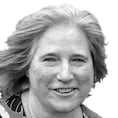Keep your eyes on the horizon, the woman sitting next to me advises. The friendly suggestion is in case of queasiness on the slightly choppy sailing. The bonus is Inishbofin coming over that horizon.
The ferry to Inis Bó Finne (Island of the White Cow), with 180 of its residents – plus temporary tourists – 10km off the north Connemara coast, takes about 35 minutes from Cleggan, after a transcendent drive through Connemara water, bog and mountain. It’s a world apart. Somehow it seems the perfect place to slide into the company of Birds of a Feather – an island experience for a Shared Island project.
The small harbour is a hive of busyness when the ferry docks, as luggage is craned off, and some 50-plus visiting Birds drift towards the island’s community centre overlooking the harbour. It’s a kind of beating heart of Bofin – remote working, music, meetings, tourism information, library, playgroup. And surely the best view from any community centre in Ireland.
For us for a few days, it’s the hub for Birds of a Feather, a project that brings together groups of women from Ballinasloe, Belfast, Ennis and Inishbofin, with various backgrounds: Catholic, Protestant, nationalist, loyalist, ethnic minorities, Travellers, inner-city working class, islanders and people with physical disabilities or mild dementia. Most haven’t previously experienced all-island collaboration. The multiannual project is a Creative Communities on a Shared Island initiative, managed by Creative Ireland at Clare County Council, partnered with Galway Public Libraries, supported by the Shared Island fund. Another sort of coming together to make a novel project happen.
For the women of Ballinasloe Women’s Group; Ballymac Friendship Trust in east Belfast; Ennis Women’s Community Group; and Inishbofin Craft Group, the aim is building mutual understanding and connections, and the key difference is it’s through shared activity, specifically craftwork.
Audrey Murray and Catherine O’Connor and a team of brilliant crafting women have put together a dizzying array of workshops and activities over three days on Inishbofin. But first, tea and home-baked buns surrounded by craft displays.
They know each other and the score already, from residential meet-ups in Ennis and Ballinasloe (for some Northern women, their first visit to the west of Ireland), and next month they’re off to Belfast, taking part in a visit that will include selling crafts at George’s Market.

On Bofin there are hard choices to be made, about which crafts to learn, with workshops in wet felting, flower-crowns, jewellery-making, weaving, knitting. There’s also sean-nós dancing, a wool-spinning demo, drama workshops with Partisan Productions, retail training, an island walking tour, a talk by Bronwyn Lavelle, founder of Sydney-based fabric print designers Karolina York, who moved to Bofin in 2022.
Over looms or threading earrings or soaking felt, sometimes there’s chatter, sometimes concentrated focus. These women are enjoying themselves. For Mary from Ennis it’s great to have “an outlet for your creativity” and to catch up with others she met in Ennis and Ballinasloe. “It was like we picked up where we left off. Everybody felt familiar with each other.” Rosanna Clineo moved to Ballinasloe from Turin a few years ago, and the group has helped her make friends, plus “English lessons for free!” she jokes. Yvonne from Ennis likes “the commonality”, getting “ideas from everyone”, and reigniting her interest in sewing.
Xandra Pienaar and her late husband, “bush babies from South Africa”, stopped in Bofin on a “gap year” in 2001 and never left. She’s now ensconced in the island community; she painted 50-plus individual watercolour cards as gifts for the Birds. Liz Keane from Galway’s library service loves the energy in the room, and watching the various interactions is inspiring, she says.
[ Walk for the Weekend: Rambling on the white sands of Inishbofin, Co GalwayOpens in new window ]
Mary from Ballinasloe thinks the trip is great. “I do feel a bit shy sometimes, but I’ve got used to making myself come and talk.” Alberta from Ballymac is enjoying “doing different things and your outlook and getting you to meet new people. We’ve never done the like of this. They’re very friendly people. We’re all mixing well together. We’re getting to know certain people and we’re having a great time.”
She visited the south when her husband was fishing. She thinks the Shared Island initiative is “a good idea. It should be more often.” Several other Ballymac women – Florence, Esther, others – weaving nearby chime in. Sometimes it’s hard getting people together for trips but “we just go. We don’t say no to anything. They’re just like us, friendly, just get on with things. You’d like to pass it on to your children, and your grandchildren, that everyone’s the same.”
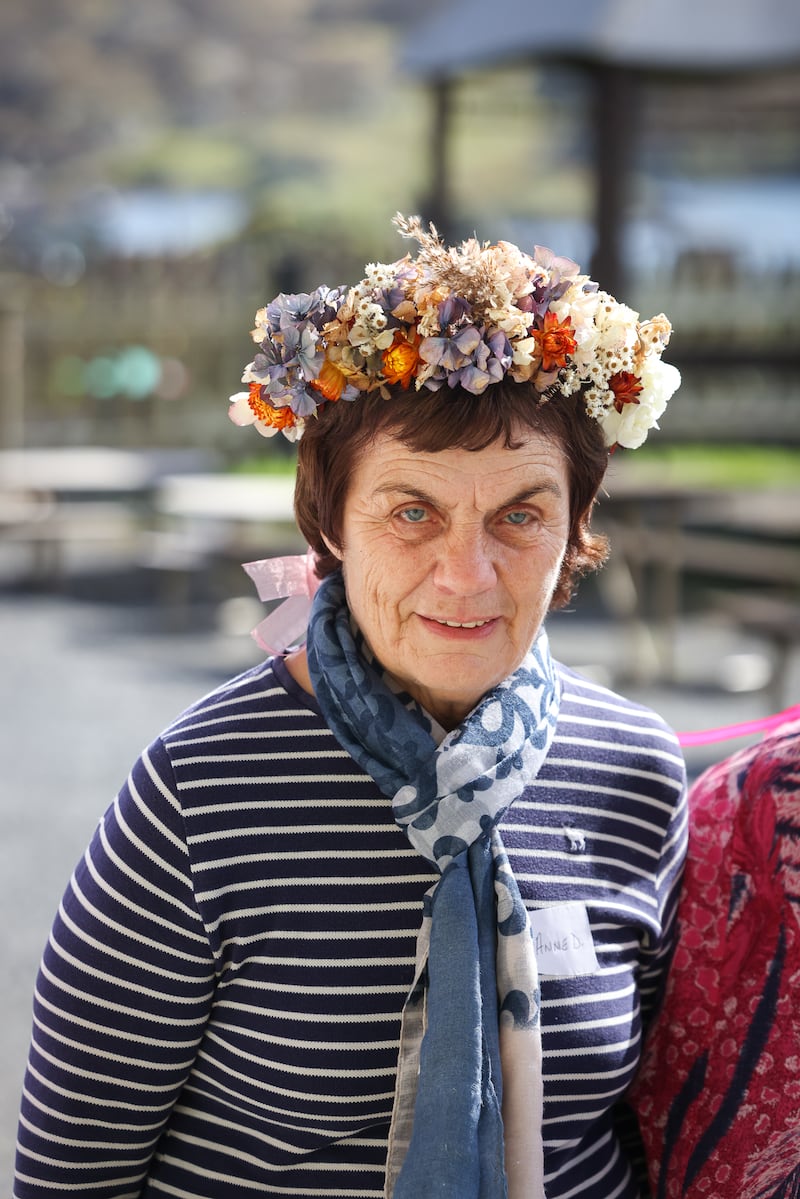
Mags McAlpin is hosting a Creating Retail Magic workshop here. A Dubliner, she has lived in Belfast since 2000 with her husband, from a Protestant unionist background. She worked on Recalling the Road memories project with the Ballymac group, then got the women involved in this Shared Island initiative. From when she first met the Ballymac women, “they took me to their hearts, and they told me so many stories. We laughed, we cried. The empathy and sadness they expressed about the loss of their own friends through the Troubles. Their best friends who were Catholics, their neighbours, told to move away. Brothers going out with Catholic girls told, ‘if you go out with her you’ll be kneecapped, or tarred and feathered’. Yet through it they remained friends with some Catholics. And here we are, and I’m this Dublin woman coming in and they just opened their lives, their hearts. They’re brilliant. Many of these women have been involved in the peace process over the years, working in community projects, and through churches.”
Eva Birdthistle, Creative Ireland’s engagement officer in Clare, has been at the centre of the initiative from the beginning. “What has surprised me the most,” she says, “is how creativity is a sort of universal language. It has the ability to quickly bridge gaps and unite us in a shared passion, no matter our background.”
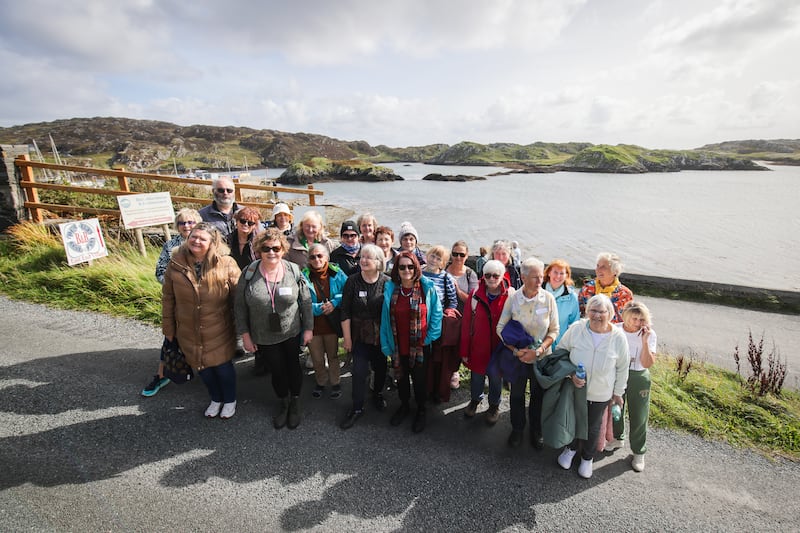
We’re split between Doonmore, Dolphin and Inishbofin House Hotels. Dolphin’s owner, Pat Coyne, drives us around the island in the hotel minibus, full of local information and humorous gossip and gentle slagging. Bofin is on the edge, yet feels connected, with lots going on in the small, vibrant community.
The next day Tommy Burke leads us down the island’s stony byways on a walking tour, by the harbour and beaches, the cemetery where the skulls stolen 130 years ago are reinterred, and to “Bofin’s last pig”, a Tamworth. He tells us about Granuaile and Cromwell and the sweep of Inishbofin history, watchout towers and houses accessed across the beach, and about growing up on the island.
[ Inishbofin skulls begin long journey home after being stolen in 1890Opens in new window ]
Along the road we run into Erin Gibbons just landed from nearby Inishlyon, where she’s lead archaeologist excavating a sunken village, along with the dig artist Dolores Lyne, and visiting Dutch artist Clodagh Lyne. We chat awhile and move on.
Burke observes how women were almost written out of island history other than as wives or daughters, yet “when I was growing up, all the people who made the decisions around here were women. It was very matriarchal. They were politically active. And every one of them loved strong men.”
Later on, Dr Máire Braniff chats about being the independent evaluator for Birds of a Feather. She has been on all the trips and seems to know everyone. She’s an Ulster University lecturer in politics and international studies, particularly peace and conflict, researching communities and positive transformation.
On the first residential outing there was a fear, she says, of the unknown. “A lot of people hadn’t, maybe, been to North or South before. What you find is women are now sending each other cards between visits, staying in contact. The first visit, in Ennis, the women kind of sat with their own groups. By the second visit in Ballinasloe, there’s more mixing.” Choosing a craft they want to learn throws people together. “It was really special. Relationships starting and fears and barriers reducing. I’m fascinated how people can build relationships while they’re busy doing other things. A lot of relationship work, traditionally, would have been: let’s get everybody into residential and talk to each other. It’s quite difficult, and needs a lot of facilitation. This is very organic. It’s about women sharing skills they’ve learned through their mums or aunties or grannies, rather than saying, ‘Okay, let’s all sit down and talk about how we feel about identity, or political issues’.”
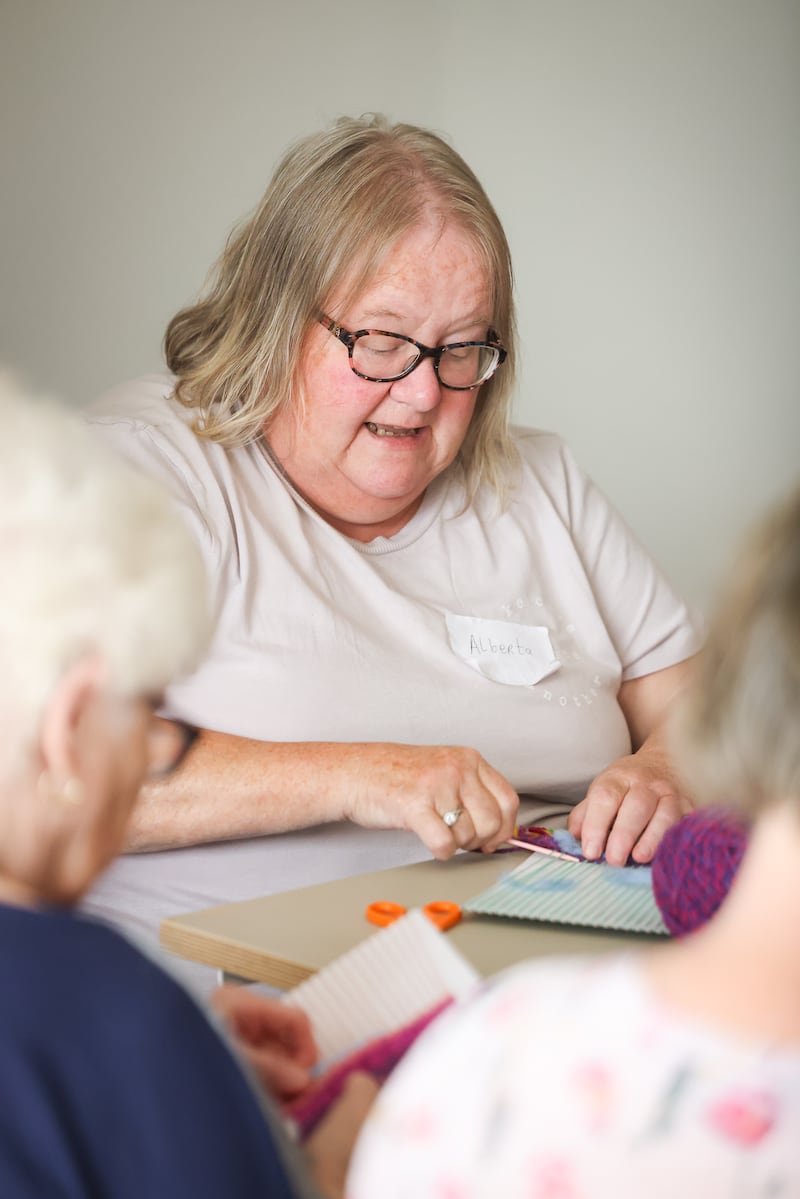
It’s been good for the Belfast women, particularly, “because first of all, they’re getting out of their very urban environment”. The Troubles were part of the Ballymac women’s teenage and adult years. “Some could have been involved in different kinds of activities, because that was part of the defence of their community.”
“There’s women from all backgrounds, but they all grew up in an area that’s still deeply segregated, by peace walls, and by more psychological barriers. They do a lot of cross-community work. But this is really incredible.” She recalls a tour in Ballinasloe, and the Belfast women particularly enjoying ghost stories and anecdotes the guide shared, “secret parts of the heritage they wouldn’t normally get. You get little points of connectivity. There was a lot about Cromwell, different battles, and they were connecting that into their heritage.”
Many assemblies and civic forums have been “useful devices to get opinions, but in this project people are navigating some of their differences in different ways. They’ve an opportunity to talk about their pasts, and they’re doing it through different mechanisms, as the project progresses.” It’s a small group of people, “but it does show you what’s possible, whenever it’s not done in an overt, political way”.
In east Belfast next month, “the other groups will see the community centre in Ballymac, get a sense of Belfast’s geography, because it’s still a deeply segregated city”. Inner east Belfast has been “hollowed out” economically and trouble continued there even after the Belfast Agreement, she says. “In 2001 we had a summer of very hot conflict in that area, lots of intimidation, fighting. It has been identified as a priority area to deal with paramilitary control and coercive control within communities. The impact paramilitary control has on generations of women, and all the issues alongside that - grooming of individuals, debt, addiction. They’re all part of the fabric of where these women come from. Over the past five or 10 years, this women’s group has become really resilient, which is quite special, including the fact that they’re even able to participate in things like this. Gender plays into this, too, so it’s important this project is a safe space for women. It’s women of all generations, and the skills they’re learning and developing here, they’re taking back to their Wednesday morning group, and passing them on. Daughters and granddaughters, it opens that horizon up for them as well.”
In her research she’s “trying to distil lessons of how we can think differently about sharing this island. It has been not only physically segregated for much of my life. I remember the Border crossings, that history. People in the South as well, are starting to come up north, to visit Titanic Museum or shopping, spending time. But there’s a lot we still have to learn about each other, on that personal level. And that’s what’s going to make us more successful.”
Chatting on the island walk later, Kate from the Ballymac group is “just enjoying every minute”. She doesn’t get south much, “because of the prices. Dublin and the South are so expensive.”
[ A truly special looped walk around the beautiful island of InishbofinOpens in new window ]
It’s a Shared Island project but “religion doesn’t even come into it”, she marvels. She didn’t know anybody from the South, she says. On the Birds of a Feather trips “you just accept who the person is. And you just go on and enjoy what they teach you”. She’s originally from rural Co Down, where life involved “struggling day to day to survive, whatever religion” people were.
“There’s still an awful lot of hurt, an awful lot of anger and grief still going on” in the North. Her three grandsons are too young to remember pre-ceasefire, “so they shouldn’t even know. But it all depends on what community you’re from. The grandfathers and the grandmothers instil that. Religion is something never, ever spoken in our house.”
There’s “a lot of mistrust on both sides, still”, and younger generations listen, watch TV, use phones and sometimes get misinformation. “There’s too much silly nonsense and misleading things out there.” Despite the tribalism and distrust, “I honestly would love to think it’ll all come together some day, but I think there’s always somebody stirring that pot.” She’s shocked at the bitterness she sees still being “handed down to the grandkids”.
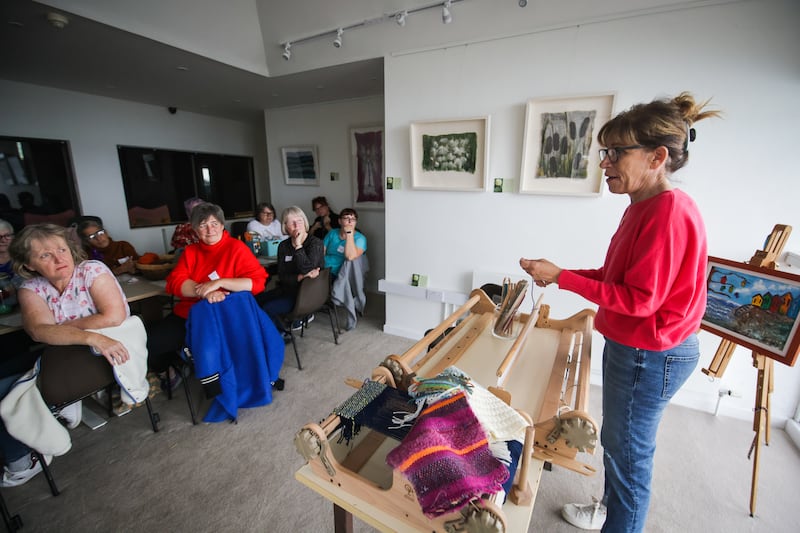
That evening some Ballinasloe friends at the House Hotel, looking out at the sea over dinner, talk about new people and new crafts: Patsi Grady, Nora Campbell, Siobhán Hegarty, Anne Duffy (who made a gorgeous flower crown that day) and Mary Lynsky (loving “every bit of the workshop”). Anne Byrnes, a member of the fire service, talks about the group’s warmth. Catherine Ó Brolchain is enjoying the adventure and the freedom of the trips. She does knitting, embroidery, upcycling, and tried weaving today.
For Rosie Darragh, the Inishbofin trip has been important. Her 31-year-old son has a rare chromosomal disorder. After years of caring for him fulltime, he’s recently gone into care, and she’s adjusting to the changes. “I had to make myself come to this, and I am so grateful that I did.”
Mary from Ballymac observes when she met the other Birds again on Inishbofin, “they didn’t feel like strangers. It felt like you knew them for years and years, and yet we only met them first in February. I don’t be over the Border much. We’ve had a really lovely time.” During the Troubles people didn’t mix “but from the minute we stepped into the community centre here, we just all gelled together”.
Birds of a Feather will be at St George’s Market, Belfast, on Saturday, November 16th

